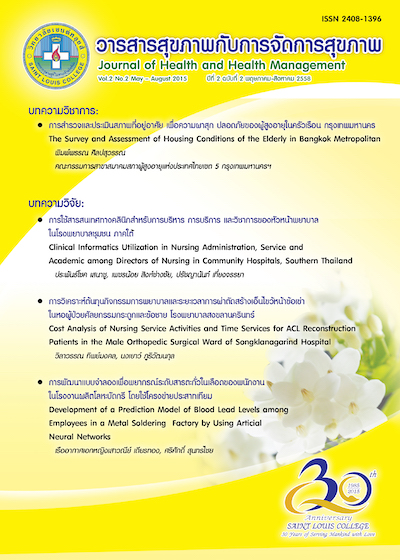Development of a Prediction Model of Blood Lead Levels among Employees in a Metal Soldering Factory by Using Artificial Neural Networks
Keywords:
Blood lead levels, Artificial neural networks, Metal soldering factory, Prediction model developmentAbstract
The objectives of this research were: 1) to investigate the blood lead levels of workers in a metal soldering factory from their annual health check-up; and 2) to develop a prediction model of blood lead levels among the workers by using artificial neural networks. The instruments in this study consisted of the data sets for developing an appropriate prediction model of blood lead levels by using artificial neural networks, and for predicting the blood lead levels This study started with the analysis of the blood lead levels of 46 workers in a metal soldering factory in Samut Prakarn Province. The workers had 10 times of annual health check-up results during the years 2008 to 2012. Blood lead levels of the workers were predicted using data input of the artificial neural networks including work experience, nature of work, health check-up results, blood hemoglobin concentration, amount of raw materials (lead and tin), and investigating results of stack and workplace air lead levels. Percentage, Pearson Correlation Coefficient, Magnitude of Relative Error, Mean Magnitude of Relative Error, and accuracy were utilized in the data analysis. The results indicated that: 1) the blood lead levels of all 46 workers from annual health check-up were less than 40 micrograms per cubic meter. Most workers had amount of blood lead 6 -10 micrograms per cubic meter (50.4%), followed by 11 - 15 micrograms per cubic meter (32.2 %); and 2) the model was suitable to predict blood lead levels with prediction error of 1.44 %. Prediction of blood lead levels of the workers by using the artificial neural networks had accuracy up to 90.17%.
References
กัลยา วานิชย์บัญชา. (2552). การวิเคราะห์สถิติขั้นสูง ด้วย SPSS for Windows, พิมพ์ครั้งที่ 7. กรุงเทพมหานคร: จุฬาลงกรณ์มหาวิทยาลัย. โครงข่ายประสาทเทียม (Artificial neural network). (ม.ป.ป.). สืบค้นจาก http://alaska.reru.ac.th/ text/ann.pdf
จงดี วินิจจะกูล. (2540). พฤติกรรมการป้องกันโรคพิษ ตะกั่วของผู้ใช้แรงงานในโรงงานแห่งหนึ่งในเขต นิคมอุตสาหกรรม ภาคเหนือ จังหวัดลำพูน (วิทยานิพนธ์สาธารณสุขศาสตรมหาบัณฑิต มหาวิทยาลัยเชียงใหม่). ตะกั่วกับการสร้างฮีมและพอร์ฟัยริน. (ม.ป.ป.). สืบค้นจาก http://cai.md.chula.ac.th/lesson/lesson4613/ lesson/main09.html
ธนาวุฒิ ประกอบผล. (2552). โครงข่ายประสาทเทียม. วารสาร มฉก.วิชาการ, 12(24), น. 73.
ณรงค์ศักดิ์ อังคะสุวพลา, สสิธร เทพตระการพร, และ ปรียานุช บูรณะภักดี. (2556). โรคพิษตะกั่ว. ใน สารานุกรมไทยสำหรับเยาวชนฯ เล่มที่ 22 เรื่องที่ ๖ อาชีวอนามัย. สืบค้นจาก http://kanchanapisek. or.th/kp6/sub/book/book.php?- book=22&chap=6&page=t22-6-infodetail02. html
ภาธสุ ดวงมาลา. (2554, 30 พฤษภาคม). โครงข่ายประสาท เทียมโดยการใช้โปรแกรม Matlab. กรุงเทพฯ: ห้างหุ้นส่วนจำกัด IBOOK ENGINEERING
มนัส สถิรจินดา. (2536). โลหะนอกกลุ่มเหล็ก. กรุงเทพฯ: สำนักพิมพ์จุฬาลงกรณ์มหาวิทยาลัย.
วิลาวัณย์ จึงประเสริฐ และสุรจิต สุนทรธรรม. บรรณาธิการ (2542). โรคตะกั่ว. อาชีวเวชศาสตร์ ฉบับพิษวิทยา. นนทบุรี: โครงการตำรากรมอนามัย กระทรวง สาธารณสุข.
สุประภาพ พัฒน์สิงหเสนีย์ สุรชัย ลิปิวัฒนาการ และ นุชนารถ ศรีวงศิตานนท์. (ม.ป.ป.). แบบจำลอง โครงข่ายประสาทเทียมชนิดแพร่กลับที่เหมาะที่สุด ในการพยากรณ์ปริมาณน้ำท่วมสำหรับแม่น้ำปิง. สืบค้นจาก pindex.ku.ac.th/file_research/ WE73.doc
สลิลา ยรรยงสวัสดิ์. (2548). สถานการณ์ตะกั่วโลก. กรุงเทพฯ: สำนักอุตสาหกรรมพื้นฐาน.
อวยพร คำวงค์ศา. (2550). โรคพิษจากสารโลหะ. ใน สรุปรายงานการเฝ้าระวังโรค 2550. สำนักระบาด วิทยา. สืบค้นจาก http://epid.moph.go.th/
Howard, B.D., Mark, B. & Martin, T.H. (1996). Neural Network Design. Boston: PWS Publishing. Shilu, T., Yasmin, E., Von, S., & Prapamontol, T. (2000). Environmental lead exposure: A public health problem of global dimensions. Bulletin WHO, 78(9), pp. 1068-1077.




